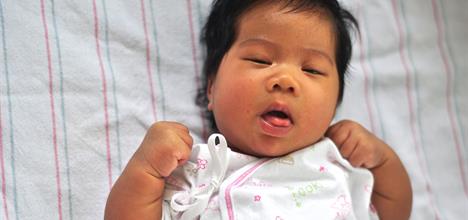Baby Cannot Be Still and Stop Moving Uncontrollably
Movement Milestones: Birth to 3 Months


Page Content
By: Courtney J. Wusthoff, Md, MS, FAAP
The offset weeks and months of a baby's life are a period of astonishing development. New skills and movements form quickly. These move milestones are often called "motor development;" they are a source of delight for babies and their families.
Hither'south an overview of some typical motor milestones to wait from birth to 3 months:
Calendar month i
Your baby volition not be able to control many of her movements during the showtime few weeks. As she begins to develop more concrete abilities, her motions may yet exist hasty or jittery. But she's learning fast, and so agree on!
-
Eyes on you. Did you know one of the first parts of the body a baby tin can move are her optics? Newborns can but see near a pes in front of them at offset, but that'south just plenty to move their optics to gaze at faces near them. Your infant may as well look toward familiar sounds and voices.
-
Neck command. Newborns tin can move their caput to the side. You may see this with their starting time feeding, when the "rooting" reflex prompts them to turn toward the nipple. Only infants don't take much neck control the showtime few weeks. Your infant needs your assistance to back up her head.
-
Newborn reflexes. In addition to rooting, your baby may show other reflex movements these first weeks. To meet the footstep reflex in activeness, hold your baby securely under his artillery (back up his head, too!) as his feet bear on a apartment surface; he may put 1 foot in front of the other in a sort of "walking" motion. This reflex disappears later on the first couple months, and virtually babies don't take their first "existent" steps until most a twelvemonth former.
Calendar month 2
Your baby's nervous arrangement has matured some by at present. Certain newborn reflexes are beginning to requite manner to voluntary motions. With improved muscle control, movement becomes more fluid and wigglier. Here's what else you lot tin can expect:
-
Heads upwardly on tummy time. Most babies this historic period can lift their caput up when lying on their tummies. Regularly giving your baby some "stomach time" is a keen fashion to help her build forcefulness in her cervix and trunk. Some will cry when placed on their tummies, but commonly do better subsequently a few tries. It helps to have something interesting, such as mom's face, in front of them and so they have encouragement to lift their head. Although too immature to really crawl, your baby may try or brainstorm to push up from a lying position.
-
Hand to mouth. During these weeks, your baby may begin to wave his arms around more when excited. Increasingly, his hands will catch his attention. He may spend a lot of time trying to motion them in front of him where he can see them. After many tries, he may be able to move them to his mouth. His finger motion is still limited, though, so his hands volition probable still exist clenched in tight lilliputian fists. Sucking on them may go a way for him to soothe himself.
-
A tug of the lips. You may have already noticed random facial movements, including reflexive smiles, while your baby sleeps. But starting old around her sixth calendar week, your baby may flash you her commencement existent grin in a genuine gesture of affection or amusement.
Calendar month Three
Your baby'south arm and leg movements continue to become smoother. The "startle" reflex is probably gone by now. She's becoming stronger and better able to coordinate her motions.
-
Straightening out. Y'all might notice your babe's whole body now looks more than relaxed. His hands will no longer be balled upwards in fists all the fourth dimension. In fact, he may entertain himself by advisedly opening and shutting them. He'll as well enjoy more than actively boot his legs, which are straightening out from their pulled-up newborn position.
-
Gear up to roll. As her kicks continue to become more forceful, she may soon exist able to kick herself over from her breadbasket to back. While nearly babies tin't roll from back to tummy however, some may brainstorm rolling over at this age. Be careful never to leave your babe lonely on furniture where they could curl over.
-
Become a grip. Babies this age may brainstorm to swipe at objects hanging merely out of attain. While a newborn reflex causes babies to wrap their fingers around objects that touch the palm, your baby's grasp may now be more than deliberate. She may even exist able to hold and shake hand toys.
-
Let'due south bounce. When held up and supported in a "standing" position on a surface such as your lap, your baby may detect the joy of bouncing. This is a fun mode to play together as your babe begins to concord some of his weight in his legs. It's best to avoid leaving babies in bouncer seats or harnesses. These can actually slow your infant's motion progress because they don't let her practice using her muscles equally much.
When to See Your Pediatrician
Remember, each babe'south movements may exist a lilliputian unlike. If your baby doesn't master her movements at exactly the aforementioned footstep others might, it is usually non because of any developmental filibuster or other problem.
It is a skillful thought to talk with your pediatrician if yous discover your baby does whatsoever of the following:
-
Stops doing something she used to practise. All babies volition have good days and bad days. They may get a few days before repeating a new skill. But, if your baby's development is going backwards or consistently stopped, talk with your pediatrician.
-
Is not using a office or side of the body. Babies this age commonly do not show whether they are left or right handed. If your baby just uses one paw or ane side of his trunk, talk with your pediatrician.
-
Seems too floppy. Young infants may seem "floppy" until they develop more musculus control. But if your baby seems specially limp or droopy, it could mean she is sick or has an infection.
-
Jitters or shakes too much. Many newborns accept shaky easily or quivery chins, but if their whole bodies are shaking, it could signal a medical problem. Call your pediatrician.
More than data
- AAP Motor Delay Tool - Use this tool to learn more almost physical developmental delays in children and when to talk with your pediatrician.
- Acquire the Signs. Human action Early on. (Centers for Disease Command and Prevention)
Near Dr. Wusthoff:
 Courtney Wusthoff, Physician, FAAP, an Associate Professor of Neurology at Stanford University and the Neurology Managing director for the Neonatal Neuro-ICU at Lucile Packard Children's Infirmary. She specializes in the neurological care of newborns and infants, and of children with epilepsy. Within the American Academy of Pediatrics, she is a fellow member of the Section on Neurology.
Courtney Wusthoff, Physician, FAAP, an Associate Professor of Neurology at Stanford University and the Neurology Managing director for the Neonatal Neuro-ICU at Lucile Packard Children's Infirmary. She specializes in the neurological care of newborns and infants, and of children with epilepsy. Within the American Academy of Pediatrics, she is a fellow member of the Section on Neurology.
Article Body
- Concluding Updated
- 8/12/2020
- Source
- Section on Neurology (Copyright © 2019 American Academy of Pediatrics)
The data contained on this Web site should non be used equally a substitute for the medical care and advice of your pediatrician. There may be variations in treatment that your pediatrician may recommend based on individual facts and circumstances.
Source: https://www.healthychildren.org/English/ages-stages/baby/Pages/Movement-Birth-to-Three-Months.aspx
0 Response to "Baby Cannot Be Still and Stop Moving Uncontrollably"
Post a Comment